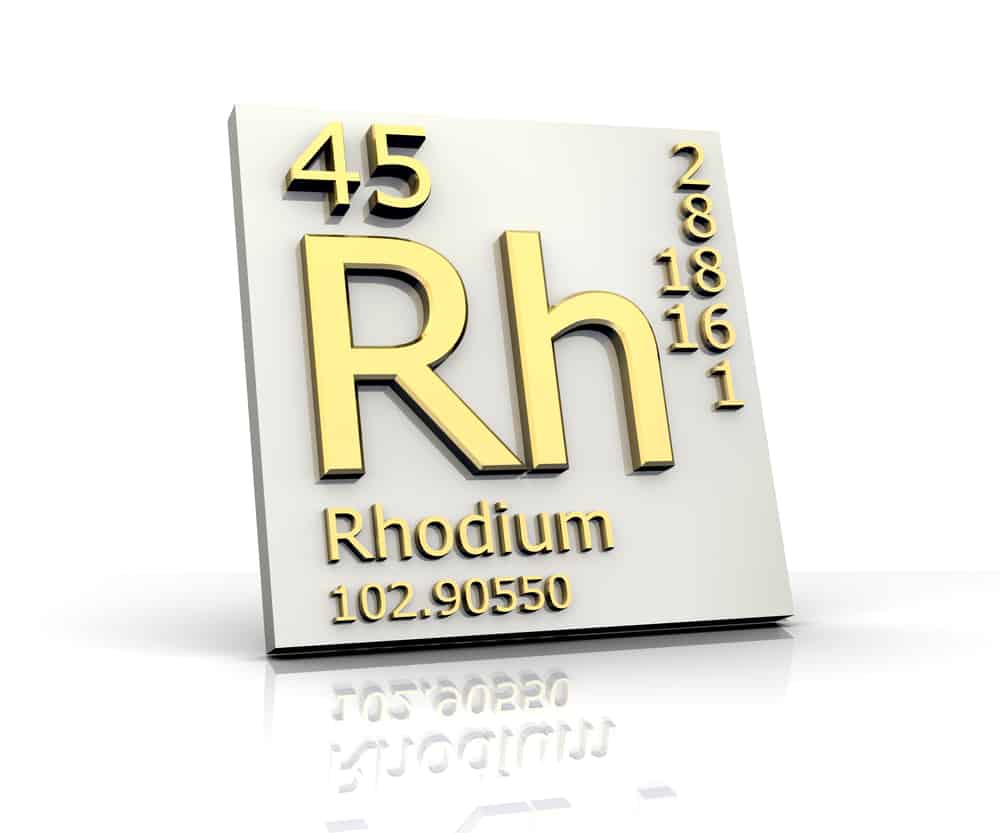Table of Contents
You’re in a jewelry store, looking for a new cool accessory to flash about town. In the middle of the conversation, the associate that’s helping you drops the term rhodium plating in your lap. You pause long enough for two questions to kick around your head: What is rhodium plating? Better yet, what is rhodium?
*This post may contain affiliate links. As an Amazon Associate we earn from qualifying purchases.
Don’t feel bad if this happened to you. You’re far from the only one. But before we can answer the first question, it’s wise to take a deep dive into the second question. It’s an important, too – it would appear that, when it comes to precious metals, rhodium’s day as arrived.
What is Rhodium?
Rhodium is a precious metal, a sub-strata of metals that includes more well-known elements like gold, silver, and platinum. It’s on the periodic table – it’s atomic number is 45 in case you’re interested – and it’s classified as a platinum group metal, or PGM. This group includes other precious metals that are rare yet rarely discussed, like iridium or ruthenium.
Rhodium is silver, although some in the jeweler business like to refer to it as white metal or white gold. Like other precious metals, rhodium is hard, shiny, and durable yet malleable. These properties have long made it an essential metal for use in the automotive industry. Specifically, it’s been a key component to the production of auto-catalysts, such as three-way catalytic converters for gas engines.
It also has another use – jewelry. Its lustrous properties make it an ideal plating component in “white gold” jewelry – that is, jewelry made from an alloy of gold and other metals. When a jeweler asks about rhodium plating, they’re asking if you want to up the bling on your ring.
A Brief History of Rhodium
William Hyde Wollaston discovered rhodium in 1803, as an isolated material from palladium. He dissolved platinum ore in a solution of nitric and hydrochloric acid, then added iron and chloride to obtain palladium. During the process, he discovered he could draw a new substance from the residual chloride. The new substance had a pink color, so he named it rhodium after rodon, the Greek word for rose.
An Unstably Priced Metal
Wollaton’s discovery is still an extremely rare commodity. It’s also one that carries an alarming volatility. For example, the price of the metal doubled from 2016 to 2017. However, the price of the same commodity dropped 90% a decade ago.
Such wild fluctuations in rhodium price are the product of an odd level of supply and demand. It’s a very rare commodity; so rare, in fact, that it’s never mined for on its own because it would be considered a waste of resources. But its demand is also one that’s relatively small. What’s more, the demand it does get typically comes from a relatively hyper-focused market. Even though rhodium’s sheen makes it an asset in the jewelry game, the automotive industry still claims over 75% of the market.
In the jewelry game, the price of rhodium jewelry isn’t privy to such wild price changes. In fact, considering its rarity and its tendency to spike when the market is going well, the prices for rhodium plating are relatively reasonable. Thin plating will usually run you about $20 to $30, while thicker plates will set you back between $100 to $200.
The Value of Rhodium Jewelry
Rhodium’s value in the jewelry market is not necessarily defined by price. Rather, it’s best appreciated by the trickery it deploys. Because it’s so bright, it could make the diamond set inside of a ring look much bigger and brighter than it is in real life. What’s more, most lighting conditions and polite distance typically conspire to keep sleight of hand a secret. Unless you know someone who is going to get up close and scrutinize your ring, your secret’s going to be safe.
The addition of rhodium plating has radically changed the look of rings, particularly wedding rings. An old-school ring passed down as a family heirloom is not going to be as shiny and flashy as a new modern ring. This doesn’t have to do with age as much as it has to do with its composition. Grandma simply never had the ability to add extra bling to her ring.
Other Benefits of Rhodium Jewelry
Even if you set aside the notion that rhodium brings extra bling to your jewelry, the rare substance does offer a few other key benefits. Some of these benefits include:
- Increased durability
- Increased resistance to scratching
- It makes the ring hypoallergenic because it’s nickel-free
Additionally, if you add rhodium plating to a silver ring, you’ll find that your ring will be less subject to tarnishing. To that end, you may look at rhodium plating as a way to temporarily protect your investment. We say temporarily because, like all good things, rhodium’s affects must come to an end.
The Transient Nature of Rhodium Plating
Despite the fact that rhodium is a durable precious metal, its durability as ring plating is lacking. Over time, that extra pop will fade away, and it has nothing to do with the rock at your ring’s center losing its power.
The length at which rhodium plating will last on a ring is as malleable as the substance is when it’s isolated. There are several factors in coming up with a ballpark figure here.
The thickness of the rhodium coat plays a critical role in its longevity. If you save money by opting for a thinner coat, prepare yourself for that shine to fade away much faster. That’s why thin coats cost significantly less than thicker coats. In this case, the phrase “you get what you pay for” is definitely in play.
Wear and tear also play a key role in longevity. If you’re plating a ring, it’s going to come in contact with objects and elements far more often than a brooch that you only wear on special occasions. Therefore, the brooch will look sharper and shinier for longer.
Ring color is also something to consider when looking for rhodium plating. Brighter-hued rings will be a lot better at masking rhodium’s shortcomings as they start to develop. If your ring underneath the plating is more yellowish in nature, you may end up with a ring that has dull spots on its surface. If it’s yellow-gold, you may find yourself returning to the jeweler for re-plating more often than you were expecting.
Of course, there’s also something to be said about the quality of rhodium plating. If your jeweler does a poor job of applying the plating, you’ll know it sooner than later. Because of this, you should only go to a shop you can trust.
Keeping Good Care of Your Rhodium Jewelry
Whether you buy a thin layer of rhodium plating for your ring or a thick one, you’re going to prepare yourself for some maintenance. As the sheen fades, this will require you to take a trip to the jeweler and request another plating application.
The time and expense of this process will vary from ring to ring. With that being said, there are a few components that will obviously expand and increase time and cost. For instance, if you’re re-plating a two-toned ring, you can expect to pay and wait more because the work is more delicate and often requires intricate application by hand.
However, this doesn’t mean that you can’t be proactive with taking care of the rhodium before it fades. Thee are a few tactics you can use at home to keep its longevity. For instance, you can keep it clean by soaking it in a little water and a touch of mild liquid shampoo. This makeshift substance will be gentle on your ring’s surface.
The last thing you want to do to clean your ring is to expose it to chemical-based cleaners. Doing so would treat the precious metal harshly, yielding less than sterling results. You’ll also want to abstain from using polishing cloths. You may be tempted to do so because they work well on gold or silver jewelry. However, rhodium is neither gold nor silver, and therefore would react much differently.
Finally, consider putting your rhodium-plated jewelry in a protective box when it’s not being worn. While this may not be feasible on a plated wedding ring, it could be a tactic you wish to deploy on a brooch or a pin.
Conclusion
Rhodium’s combination of rarity and price volatility make it one of the world’s most fascinating precious metals. From an everyday consumer standpoint, it’s purpose is all about the bling that it can add to a ring. This makes it a beneficial precious metal, but be forewarned: unlike a diamond, rhodium plating is not forever.
Yet don’t let that dissuade you from adding a touch of rhodium to your next piece of jewelry. It may cost you a little bit more, but the dazzling shine it provides – and the eyeballs it will invariably attract – make it worth shelling out the extra cash.

